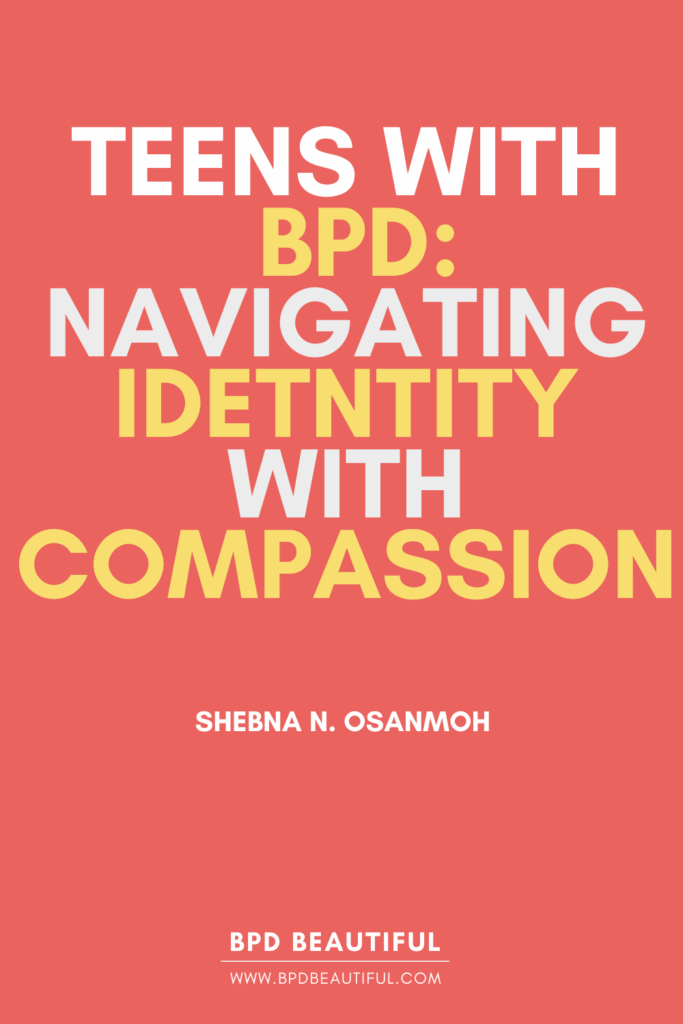Teens with BPD: The Search for “Who Am I?” in a Storm
Mia’s story: Mia was sixteen when she first realized she didn’t know how to answer a seemingly simple question: “Who are you?” On Monday, she was convinced she wanted to be a fashion designer. By Thursday, she’d cut her hair short, dyed it purple, and announced she was going to study political science. Her bedroom walls were covered with vision boards that never lasted longer than a month. Her style, opinions, and even her closest friends shifted like clouds in a windy sky. For Mia, every mood, friendship, and conflict had the power to reshape her sense of self completely. And although identity experimentation is a normal part of adolescence, the intensity and rapidity of these shifts pointed to something deeper: the identity disturbance characteristic of BPD.
Looking to better understand BPD? Sadie’s Favorite: A Novel + Original Soundtrack explores BPD, trauma bonds, FP relationships and healing after emotional abuse. Click to learn more.
Adolescence is already a period of profound change. It is a time when haircuts, wardrobes, friendships, and dreams shift like waves in the ocean. For many teens, self-discovery is a winding road — but for teens with Borderline Personality Disorder (BPD), the journey can feel like a chaotic sprint with no clear destination. For teenagers, these changes can feel like the tides themselves are out of their control. The search for identity — a developmental rite of passage — becomes a disorienting journey where the map keeps rewriting itself. For many parents and caregivers, watching a teen’s self-image transform week to week can be both confusing and heartbreaking. Understanding why identity feels unstable in teens with BPD is the first step toward compassion and practical support.
Here we’ll explore why identity feels unstable in teens with BPD, what’s happening inside their minds, and how parents and caregivers can support a teenager whose “self” feels like it’s always in motion.
Understanding BPD in the Teenage Context
BPD is often defined in clinical terms — instability in mood, relationships, and self-image — and is often associated with intense emotions, relationship problems, and impulsivity. But for teens, these concepts are lived out in visceral, daily experiences. Unlike the typical self-exploration of adolescence, identity disturbance in BPD is often tied to emotional storms and a desperate search for validation.
Key characteristics of BPD in teens:
- Rapid shifts in self-image — one day confident and outgoing, the next withdrawn and insecure.
- Contradictory goals and values that change from week to week.
- Dependence on external validation to feel “real” or valued.
- Difficulty describing “who they are” without referencing relationships or temporary interests.
📊 Stat Insight: According to a 2023 review in Child and Adolescent Psychiatry, up to 3% of adolescents meet diagnostic criteria for BPD, with symptoms often emerging by mid-teen years.
For parents, the challenge lies in recognizing when changes in a teen’s identity are part of healthy growth and when they are signals of severe distress. This is not about discouraging exploration but about understanding the emotional undercurrents that make the journey so turbulent for those with BPD.
Why Identity Feels So Fluid
Jake’s story: Jake, a seventeen-year-old who had been working tirelessly toward a soccer scholarship. He attended every practice, watched game footage to improve his techniques, and dreamed of playing professionally. Then one afternoon, after a heated exchange with his coach, he quit the team. By the end of the week, Jake had enrolled in a theater class, telling everyone he had “never liked soccer anyway.” For Jake, this wasn’t simply losing interest; it was an emotional defense mechanism. By rewriting his identity, he could avoid confronting feelings of failure and vulnerability.
During adolescence, the teenage brain is still under construction, particularly the prefrontal cortex — the area responsible for planning, decision-making, and self-reflection. For teens with BPD:
- Emotional dysregulation can override rational thought, leading to identity shifts based on current mood.
- Fear of abandonment may cause them to adopt the values, styles, and opinions of others to feel accepted.
- Black-and-white thinking can turn yesterday’s passion into today’s rejection.
When feelings change rapidly, so too does the sense of self. A disagreement with a friend might lead to abandoning an entire hobby. A fleeting romantic connection could inspire a complete reinvention of appearance or interests. Unlike typical teenage changes, these shifts are often driven by an urgent need to avoid emotional discomfort, rejection, or perceived abandonment.



Sadie’s Favorite: A Novel + Original Soundtrack is a character-driven story about BPD recovery, trauma bonds and breaking away from abuse.
The Emotional Rollercoaster and Its Impact on Identity
Sofia’s story: Sofia, 15, often described herself as “a different person” with her friends compared to at home. With her friends at school, she was the “fun party girl – loud, adventurous, and a risk-taker. At school, in certain classes, she became a diligent overachiever. At home, she was quiet, withdrawn, and cautious. Her therapist helped her see that both versions were real — but neither felt consistent or stable to her. While many teens adapt their behavior to fit social situations, for Sofia, these shifts weren’t just about manners or roles; they left her feeling hollow and disconnected, unsure which version of herself was real.
BPD’s hallmark is emotional intensity. The emotional rollercoaster of BPD intensifies the instability of self-image. Three patterns often emerge:
- Mood-dependent self-concept — a teen’s identity can be mood-dependent: when they feel confident and connected, they might present as outgoing and ambitious; when they feel hurt or anxious, they might retreat and adopt a completely different persona.
- Relationship-driven identity — identity may be heavily relationship-driven, shifting according to the people they are closest to at the moment.
- Crisis-triggered transformations — crises, even minor ones — can spark sudden reinventions, as if shedding one identity might erase the pain tied to it.
Signs That Identity Disturbance May Be More Than Typical Teen Change
It is important to remember that some degree of identity experimentation is expected in adolescence. It’s normal for teens to experiment with fashion, interests, and social groups. Changing hairstyles, exploring new hobbies, or shifting friend groups are part of the developmental process. But in BPD, these changes often feel more like survival strategies than natural growth. They are accompanied by distress, shame, and an underlying sense of emptiness. A teen might abandon a passion overnight, not because their interests evolved, but because a triggering event made it unbearable to continue. So, when identity changes are linked to emotional crises and cause distress, they may signal BPD.
Parents must watch for:
- Frequent, dramatic changes in life goals.
- Difficulty answering basic questions like “What do you enjoy?” or “What are your values?”
- Self-descriptions that rely on others (“I’m whoever my friends need me to be”).
- Sudden abandonment of hobbies, friendships, or commitments.
- Signs of intense shame or emptiness when alone.
How Parents and Caregivers Can Help Teens with BPD
Supporting a teen with identity disturbance means balancing guidance with acceptance. As a parent, encouraging your teenage kids to explore themselves without pressure is the key. A teen with BPD may need reassurance from his/her parents that they can try new things without committing to them forever. Modeling stability in your own life — keeping your routines, values, and boundaries consistent — as a parent, you can provide a silent example of what steadiness looks like. And by introducing emotional regulation tools, such as mindfulness practices or grounding techniques, you can help a teen slow down before making identity-altering decisions.
- Validate feelings, not identities. “I hear you’re feeling uncertain about yourself right now,” instead of “You’re not really like that.”
- Encourage exploration without pressure. Let them try new things without demanding permanence.
- Model stability. Show consistency in your own values and behavior.
- Teach emotional regulation skills. Mindfulness, grounding exercises, and dialectical behavior therapy (DBT) can help.
- Create a safe home base. A consistent routine can anchor them during identity shifts.
Realistic Expectations for Identity Growth
Parents often feel an understandable urge to “fix” their teen’s confusion, especially when that confusion seems to cause distress or instability. However, identity development is not a problem to be solved overnight—it is an evolving, sometimes messy, process that takes time.
For teens living with Borderline Personality Disorder (BPD), this journey can be even more complex, as their sense of self may shift rapidly or feel fragile. Progress, in this context, often appears in subtle but meaningful ways. It might look like longer periods during which the teen’s values, goals, and interests remain steady, rather than changing drastically from week to week.
It can also be seen in their growing ability to pause and self-reflect without immediately spiralling into harsh self-criticism or despair. Perhaps most importantly, progress involves building a “core” sense of self—a steady inner identity that stays intact, even as external preferences, hobbies, or opinions evolve.
This inner anchor provides a foundation of stability, allowing them to navigate life’s changes without feeling completely lost.

As a BetterHelp affiliate, we receive compensation from BetterHelp if you purchase products or services through the links provided.
When to Seek Professional Help for Teens with BPD
Emily’s story: Emily, sixteen, spent what she calls her “chameleon years” cycling through five different friend groups in a single school year. Each time she joined a new group, she adopted their style, music tastes, and slang. When friendships inevitably ended, she felt as though she had lost a part of herself. Through therapy, Emily learned to identify the interests and values that had remained consistent through all those changes — her love for drawing, her empathy for others — and to use those as touchstones during times of uncertainty.
Parents and caregivers can play a vital role in supporting a teen through these changes. Rather than questioning the authenticity of a new interest or dismissing a sudden shift, acknowledge the feelings behind it: “It sounds like you’re really excited about this right now,” or “I can see that you’re feeling unsure about yourself today.”
In some cases, identity instability may progress to the point where professional intervention is needed. This is particularly true if it is accompanied by self-harm, suicidal thoughts, or severe mood swings. Evidence-based treatments like Dialectical Behavior Therapy for Adolescents (DBT-A) have shown promising results in helping teens develop a more stable sense of self over time. Family therapy can also help parents understand triggers and develop healthier ways of responding.
Treatment options:
- Dialectical Behavior Therapy for Adolescents (DBT-A) — evidence-based and highly effective for BPD.
- Family therapy — helps parents understand triggers and responses.
- Individual therapy — supports emotional regulation and self-awareness.
Chris’s story: Chris, eighteen, took what he jokingly called “the career carousel.” Within a year, he announced plans to be a chef, then a paramedic, then a social media influencer. Each change was accompanied by an intense burst of activity — researching schools, buying equipment — followed by abandonment when the initial excitement wore off or when a challenge arose. DBT helped Chris recognize his tendency to equate identity with short-term passions. Over time, he learned to approach new interests as experiments rather than definitions of who he was.
Latest Research and Hope for the Future
A 2024 study in the Journal of Personality Disorders found that early intervention in teens with BPD symptoms can significantly reduce identity disturbance over 2–3 years. This suggests that recognizing symptoms early and providing structured support can make a meaningful difference in a teen’s trajectory.
Final Words
For parents, the journey alongside a teen with BPD can be exhausting. Watching them shift identities can feel like chasing someone through a maze where the walls keep moving. But the goal is not to force them into a fixed mold. Instead, it is to be the constant — the person who stays the same when everything else feels in flux. Over time, with understanding, patience, and therapeutic support, many teens do begin to find a more grounded sense of self.
In the end, identity will always evolve, especially in the teenage years. But for a teen with BPD, the task is not about settling on one unchanging definition. It is about developing the resilience to navigate change without losing themselves entirely. The moving target may never stand still, but with the right guidance, they can learn to keep their footing as they aim.

Looking for BPD Characters?
Sadie’s Favorite explores the dynamics of Borderline + Narcissist Relationships and BPD Recovery. Read first 6 chapters.
BPD Resources
BPD in Fiction: Sadie’s Favorite is a Novel + Original Soundtrack, that touches on BPD, favorite person (FP) relationships, healing after abuse, parenting and more. Written by Sarah Rose, creator of BPD Beautiful. Soundtrack performed by Them vs. Her.
Get 20% off your first month of BetterHelp. Get matched with a licensed therapist within 48 hours. Subscriptions as low as $65/week, billed every 4 weeks. Cancel anytime.
Manage your BPD symptoms with a printable workbook.
See our recommended list of books about BPD.
Start a Discussion
Have you tried incorporating these tips to help you in managing the intense emotions that come from having BPD &/or anxiety? Tell us about it in the comments.
Pin this Post
Liked this post? Please help support BPD Beautiful and spread borderline personality disorder awareness by pinning it to Pinterest.




